#specifically a butterfly habitat
Text
i have to complain to the void
#skeleton diary#oh god i hate this#last week my best friend and i made plans to visit a science museum#specifically a butterfly habitat#(they're my favorite)#her bringing it up and making plans there on the spot made me so happy#so happy i could cry honestly#i realized shortly afterwards how happy it made me#and remarked to myself how i hadn't felt that happy in literal years#i feel so safe and understood around her#like i don't have to be anyone else but myself for once#and seeing butterflies with her would make me so happy#to be so vulnerable and so surrounded by beauty#it was so exciting#until she messaged me a lil bit later to ask if her boyfriend could tag along#she said it'd make her feel uncomfortable if she did something special without him#keep in mind i have only seen and shaken this man's hand /once/#it makes me so upset.#the wonder the joy the safety all stolen from me because of this boyfriend#i have really bad social anxiety so feeling so safe around her is a feat in and of itself#having to meet and hang out with a stranger sounds like TORTURE to me#admittedly it's caused me to reevaluate my feelings for her in a very real way#(i'm incredibly smitten but that doesn't mean i'm right for her or that she even has those feelings for me)#but the point still stands!! i don't want this experience ruined by some bozo who's insecure about me hanging out w his gf so much!!!#i'm going to have to switch plans hardcore and soon because i've thought about it enough to know it's not impulse
5 notes
·
View notes
Text
Becoming a gardener has made me discover so many different types of bugs that I never knew about. I had no idea that my area had so many native bees (there's a species of North American bee that only visits squash plants!! there are bright green metallic bees!!). I've seen bugs behave in ways that I've never found anyone talk about irl or online (a garden near me has a catnip plant that is ALWAYS covered in blue mud dauber wasps, why?). I've learned that there's many, many bugs and other creepy crawlies that are impossible to find information about online for whatever reason, and there's many spiders specifically that I've never been able to find the names of.
It's also made me terrifyingly, devastatingly aware of how few bugs there are compared to when I was a kid and that those numbers are visibly dropping every year. Butterflies are still a rare sight, no matter how hard I try. I'm getting more bees visiting my squash and bean plants, but less in the flowers. The wasp nest that was built near my window like it is every year is considerably smaller than previous years, even with more material to build with and a consistent source of water nearby. There's fewer grass spiders and the huge orb weavers I loved so much have disappeared completely in the last couple years.
We've stopped raking the leaves. We've planted more things, even started a wildflower garden. I've set out bug baths and a bee house. I'm planning on planting more next year, but will that even help? How can my little yard even begin to undo just a fraction of a fraction of the damage done by climate change and massive loss of habitats?
This isn't meant to be a doomer post, so please don't lecture at me like it's one. I'm just tired and sad and I miss my spiders.
581 notes
·
View notes
Note
Uh, I saw your post and you mentioned that you teach the kids... how do I put it... that are given to you at social functions due your park ranger aura for safekeeping how to tell the difference between predatory lightning bugs and normal lightning bugs.
And then you didn't tell us that secret! May I ask you to share the difference between predatory lightning bugs and normal ones?
Thank you very much :)
By popular demand and because this was the most polite ask: how to tell the predatory lightning bugs from the non-predatory lightning bugs.
First, there are over 2000 species in Lampyridea. I am not qualified to distinguish between all that. I grew up in Northern Ohio (71 species) and every year summer wasn’t official until the lightning bugs came out in the evenings (usually the first or second week of June).
This is our first clue. The first lightning bugs out each evening are a species of non-predatory chaps. Their glow goes in a special pattern. Flash, pause, “J” shaped flight about 2 -3’ off the ground. Repeat. Their glow is more yellow and lingers. These are the males of Photinus pyralis or the common eastern firefly. They look like this:

(Photo from iNaturalist: a lightning bug beetle, mostly black with gold lines around the wing casing. Head shield is yellow with a red “eye” with black iris in the center. Rounded front and back, long down the center.)
Their females hide in tall grasses waiting for the right suitor. If you’re lucky and clever you can see her dimmer flash in the grass beaconing the males closer.
As the dark of night progresses you’ll start to see a quicker, brighter, greener flash. Blip, blip, blip, blip, long pause. They are FAST! They’ll also mimic the flashes of Photinus females. These are usually higher up off the ground. Even in the trees! These lightning bugs aren’t looking for love.
Photuris (not gonna get to specific epitaph on this one without a sample and a key) are looking for dinner!
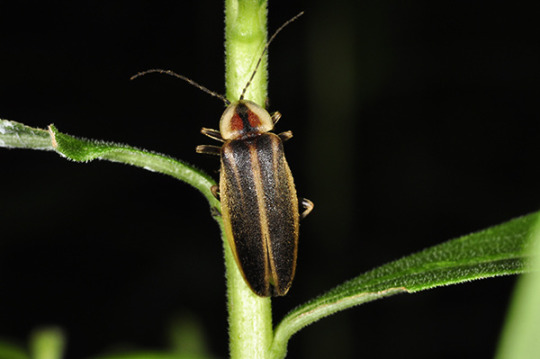
(Photo from blog.greatparks.org another lightning bug beetle. This one is slightly larger than the non-predatory bug. It has “shoulders” and extra gold lines running through the back. Its legs are longer and its shield is more “sharp”. The shield marking is less like an eye and more like a yellow D where the inside is a red triangle with a black line running through.)
Another way to tell is to go out at night and catch a bunch of lightning bugs (if you can; I hear they’re getting scarce). Offer them a slice of apple. If you wake up in the morning to only a few and the rest are dead, good chance you found some predators. (This is how I found out about them! Wooops!!)
Lightning bugs are freaking magical. I’m so sad to hear that they are yet another wonder that we are losing at an alarming rate. If this bugs you as much as it bugs me there are a few things you can do to help them:
1) do not spray for mosquitoes! That spray is not-species specific. It’s bad for lightning bugs. It’s bad for monarch butterflies. It’s bad for birds. It’s bad for bats. It’s bad.
2) kill your lawn. But Misha! You said they breed in the grasses! True! However native plants are going to provide so much more habitat for these guys than a gross monoculture of Kentucky bluegrass ever will. The Midwest has some of the best native plant nurseries in the country! Use that resource!
3) Advocate for them and donate to conservation if you’re able. Bugs don’t have voices and they fight an uphill battle just for being a bug.
Thanks for joining my ranger talk! Support your parks.
252 notes
·
View notes
Text
Moth of the Week
Spanish Moon Moth
Graellsia isabellae
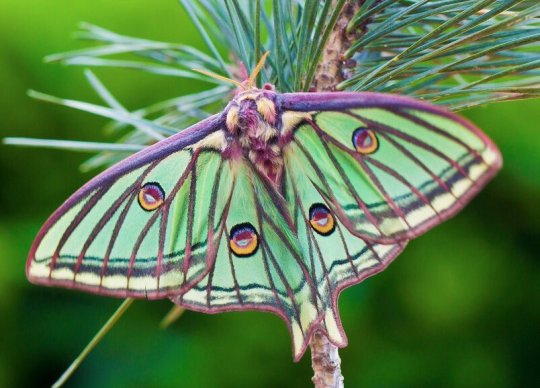
The Spanish moon moth was first described in 1849 by Mariano de la Paz Graells y de la Agüera as Actias isabellae. However it was moved to the genus Graellsia, which was created in 1896 by Augustus Radcliffe Grote. It is part of the moth family Saturniidae and often associated with other “moon moths” under Actias although this species split off years ago. It is the only species in Graellsia and has no subspecies, making it a monotypic genus.
Description This moth has green wings with reddish-brown lines and yellow-green hindwing tails. These lines border all four wings and trace over the moth’s veins. The lower edges of both the hindwings and forewings (called the outer margins) are lined with black and the same yellow-green as the tails. This yellow-green is also seen on the forewings close by the moth’s head and on the hindwings in a gradient. Each wing has a magenta, orange, white, and black eyespot in between its veins with the hindwing spots being larger.
The body is yellow-green as well with reddish brown patterning. The antennae can be dark or orangish-brown.
The males have longer tails and bushier antennae while females have stubby tails and larger bodies.
Wingspan Range: 6.35 – 10.16 cm (2.5 - 4 in)
Diet and Habitat The caterpillar of this species eats pine needles, specifically from the Pinus nigra (Austrian Pine) and Pinus sylvestris (Scots Pine), which are native to its habitat. Interestingly, this species doesn’t easlily adapt to eating non-native pine species even if they are from the same genus.
This species is native to Spain and France but is also found in Switzerland. They live in the Alps and the Pyrenees mountains, which are considered a “refugee location.” Due to the cool, dry, and unchanging climate the Spanish moon moth has been able to remain unchanged for thousands of years. It is also a protected species.
Mating Adult moths hatch at the end of April to early May. The females lays 100 to 159 eggs, using pines as host plants. The eggs hatch after 1 to 1.5 weeks. It is important to note that adult from the same family will not mate with each other.
Predators Presumably, this moth uses its eyespots to imitate a larger animal and scare away predators.
Fun Fact A hybrid moth species was created by breeding the Spanish moon moth and the Indian moon moth (Actias Selene).
(Source: Wikipedia, Moth Identification, The Butterfly Babe)
#libraryofmoths#animals#bugs#facts#insects#moth#mothoftheweek#lepidoptera#Saturniidae#spanish moon moth#Graellsia isabellae
430 notes
·
View notes
Text
Right now you can plant specific flowers or trees or shrubs...and as if my magic...the butterflies and bees and moths that rely on those plants will just appear. I think of that as a little miracle, one we maybe take for granted.
My biggest fear is the day that no longer remains true. The habitat too fragmented...for those animals to find your little oasis anymore.
108 notes
·
View notes
Text
There's a nice to read New York Times article today about what local environmental action can amount to
If you don't have a NYT sub (stupid paywalls) I'll offer a lil synopsis.
The main woman of the article is someone who cares a lot about monarchs, and knows a few patches of milkweed that keep getting mown with monarch eggs on them.
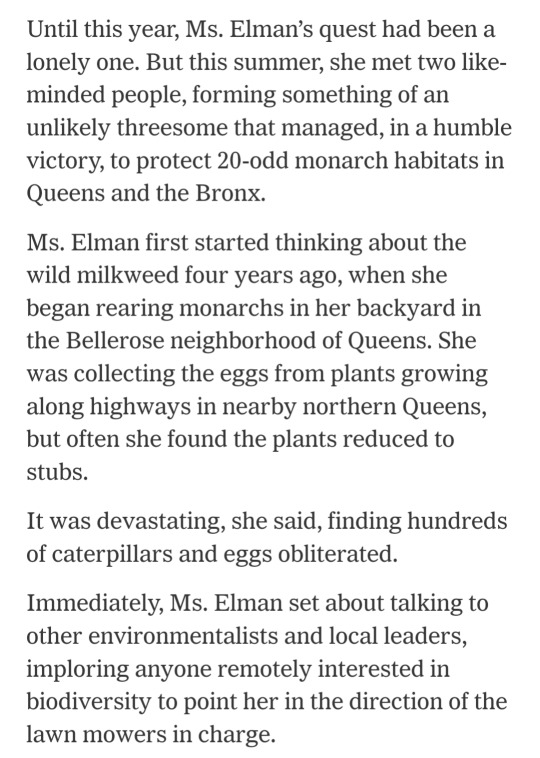
She talked to SO MANY local leaders, gave presentations, but they didn't find fruit. UNTIL she talked to the director of arterial highway maintenance who finally listened.
What's so interesting to me isn't that he listened, not necessarily because he wants to do the right thing etc etc, he listened because so many other had talked to him about it before. The people in the article are the people who finally broke the dam and made someone listen enough to take action. But the article mentions people for about six years who bring up saving the milkweed for monarchs.
In the end, there are now 20 patches of milkweed along highways that are unofficially protected, and grew until hatching season. Change did happen!
What I like about this article is that it's a little case study in the long game of community, it takes time, it takes effort, and it takes finding the right people at the right time. That is specific, but shouldn't be daunting. Because if you find that you aren't being listened to, there's still a chance for another person to hear you, or, maybe down the line you help make this issue bigger, Because six months from now someone comes up with the same issue as you, and because you made a big deal now, that person has more of a foothold later.
But also, I wonder what could've happened if all the people from six years asking for monarch milkweed protection found each other earlier and gathered together ?

326 notes
·
View notes
Text
What to Do Once Things Are Planted?
This is my seventh post in a series I’ll be making on how to increase biodiversity on a budget! I’m not an expert--just an enthusiast--but I hope something you find here helps!

So you’ve gotten started on making a garden to boost biodiversity! 10/10, excellent work! So, now what?
First, you’ll need to keep watering the plants--especially if you’re going through a dry season. Native plants will be more acclimated to your area’s seasonal weather, but they’ll need a helping hand while they’re getting established--especially if you’re starting with young, tender seedlings. With that in mind, if you accidentally skip out on crucial watering days, don't panic! There's been tons of times where I haven't watered for an entire summer and had perennials come back the next spring! Even this year, during a heatwave, I completely did not water my swamp milkweeds, but they're already popping back up! You may also need to go in and weed, especially if you’re seeing invasive species popping up in the garden. Invasives are no good--if you do anything, do your best to get those out as effectively and safely as possible!
If you’re needing to maintain your shrubs in spring and summer, double check to make sure there are no active bird or insect nests within them. If it’s possible to wait until later to cut your shrubs, it could be extremely beneficial.

When fall and winter come around and your plants begin to die back, don’t cut them away if you can! Many insects overwinter in the plant stems left behind as perennials die back to the roots. In addition, birds will use seed heads as a source of food over the winter. Try not to clean things up until late winter/early spring, when other food sources are beginning to come back and things are growing again. By then, the insects should be waking up and leaving the plant stems as well.
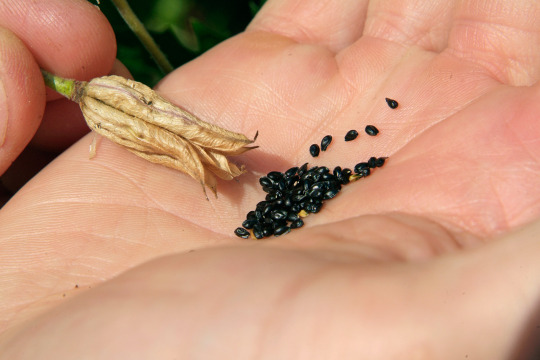
However, don’t let this discourage you from collecting seeds! Collecting seed from your plants is a great way to continue gardening at low cost, as well as making friends and encouraging others to garden by trading seeds or offering them as gifts. If you're in an area where you do need to cut back, this is a great opportunity to collect the seeds and save them for the future. You could also cut back what’s dying in the front yard and keep things to overwinter in the backyard. Some overwintering habitat is better than no overwintering habitat.
Want to know how to collect seeds from specific plants? I've found YouTube to be a great source of info for this! Knowing what you're doing and when is key to getting a viable harvest.
As your mulch begins to break down, you’ll need to keep adding more to top it off, if you can. It can get a bit repetitive, but no worries--the mulch breaking down means your soil is improving!
If possible, add to your garden! Expand, add in new things, and keep encouraging the growth of native plants. If you couldn’t add that water feature in year one, see if you can in year two! New interest in birds? Add a birdhouse, or more bird feeders. Loving the butterflies? Add plenty more nectar-rich plants, or do more research into what they lay their eggs on! Want more color? See what else you can add in! Came into some new pots to expand your flowerpot garden with? Find cool native plants to put in them! I always encourage people to start small and then expand over time, as opposed to starting big and getting overwhelmed.
Keep learning and observing native species of birds, insects, mammals, etc. See what’s coming to your yard now, and look into how you can improve things more for them on your budget. If you aren’t seeing what you were hoping, see if there’s other actions you can take that’ll attract what you’re hoping to see in your backyard habitat. Knowing more about the world around you makes it easier to know how to help the world around you. Talk to others about what you’re doing, the changes you’ve made, and the results you’ve seen! Curious neighbors? Work friends? Your closest homies? Your family? All fair game! You just might be the one who gets someone else interested in making their space a habitat for local wildlife!
That’s the end of this post! My next post is gonna be about the secret Other Thing you can do to help biodiversity--tackling invasives! Until then, I hope this advice was helpful! Feel free to reply with any questions, your success stories, or anything you think I may have forgotten to add in!
#biodiversity#solarpunk#gardening#outdoor gardening#ani rambles#out of queue#the biodiversity saga#at least it hasn't been 2 months since the last post amiright#i know its september so by this point a lot of northern hemisphere folks are winding down on gardening#buuuut winter's a good time to buy seeds for cheap! and for plotting and planning#and meanwhile the southern hemisphere will be just gearing up!#either way I hope this advice has been helpful so far!
355 notes
·
View notes
Text
I'm going to start an HOA community that enforces anti-lawns. Only native grasses/native wildflowers/pollinator habitats allowed. Plants are required to be at least 6 inches tall. If you want a traditional grass yard, it has to be the backyard, and you need to go through an HOA application with specific reasoning (pets and kids are the only justifications). Every lot is required to have a produce garden that provides for that household. HOA funds go to continuing the community garden that gives back to the community in the form of zucchini bread and canned vegetables. Beehives and butterfly feeders encouraged.
121 notes
·
View notes
Text
Things of dire importance about Outside in no particular order:
butterflies and many other beneficial insects spend the winter hibernating in fallen leaves. Please try to avoid shredding them, burning them, or God forbid, sending them to a landfill.
fallen leaves make amazing mulch and compost and getting rid of them is Incredible Folly
it is fine and normal for your plants' leaves to be munched on a little bit by bugs. if you plant a native flower, there's probably a butterfly or moth species whose caterpillars eat it for food. The babies have to eat okay. It's natural! It's good!
mushrooms=good. It is not a problem to have mushrooms in your yard. Most plants are in symbiotic relationships with fungi, that's how they get most of their phosphorous and nitrogen.
At least in the USA, no mushroom will poison you just by touch (barring allergies or some sensitivity like that I guess?). Unless you eat them, mushrooms will not hurt you.
If you happen to have a stream running through or alongside your property, do NOT mow right up to the edge. Plant moisture-loving trees, shrubs and plants to form a buffer zone. This helps stop harmful chemicals and pollutants from going into the water, prevents the stream bank from eroding, helps mitigate the risk of flash flooding, and creates absolutely essential habitat for some of the world's most at-risk creatures.
Trees can usually be planted as close as 6-10 feet apart from each other, but large trees should be kept 25+ feet from structures and septic tanks. Landscapers regularly plant trees WAY too close to structures.
Most butterflies and moths depend on specific plants for food for their caterpillars, hence the importance of native plants.
Many important bees hibernate over the winter in logs and stumps. Logs and stumps are good!
Acorns are ripe when they have fallen to the ground, they are brown and their little hats have popped off. If you rummage around in leaves under oak trees in October or so, you may find acorns that have already begun sprouting. You can put it in a pot and grow a new oak tree. (Sprout side down-that's the root!) It's so easy it feels illegal.
This is not true of some oak species, specifically white oaks (the ones with rounded lobes on their leaves- that's the simplified explanation). Their acorns have to experience a few months of cold before they sprout, so they will sprout in the spring, not fall. (Edit: I got it mixed up, it's red oaks that need cold to sprout and white oaks are the ones that can sprout immediately! Oops)
SO MUCH STUFF is going to seed right around the time that the leaves are falling. You can gather seeds from plenty of wildflowers along basically any weedy path or roadside.
thats all i've got for now
1K notes
·
View notes
Text

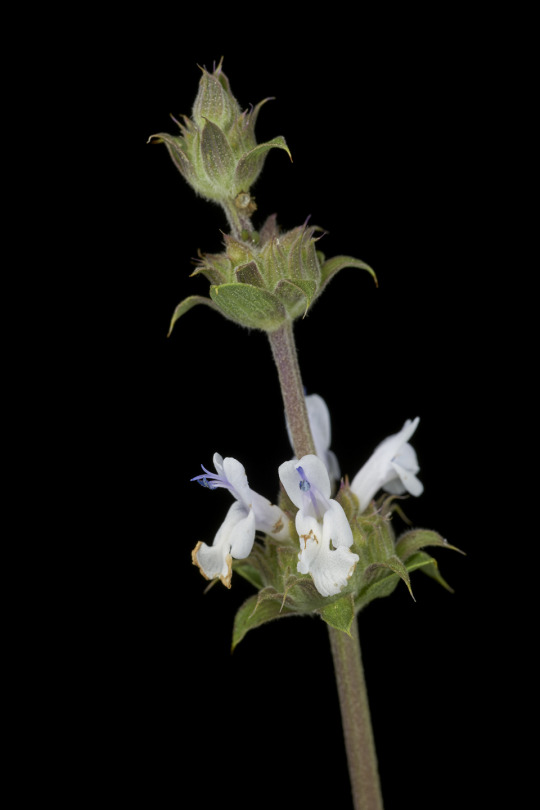
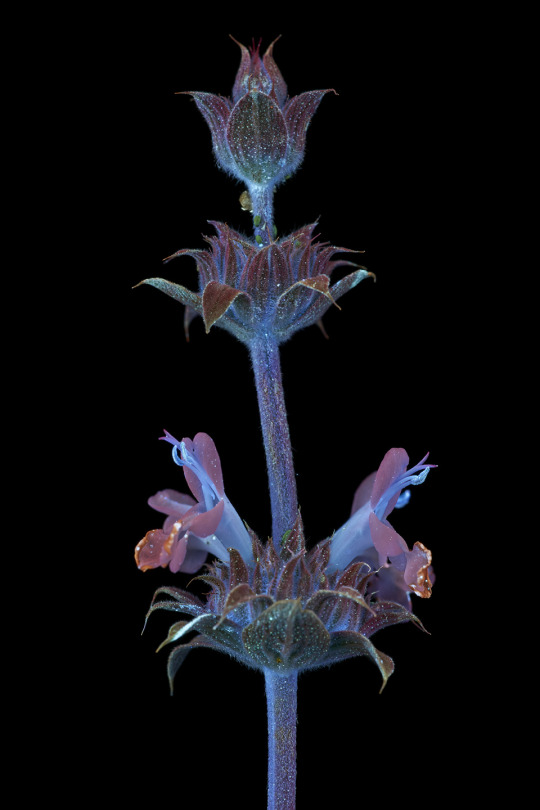
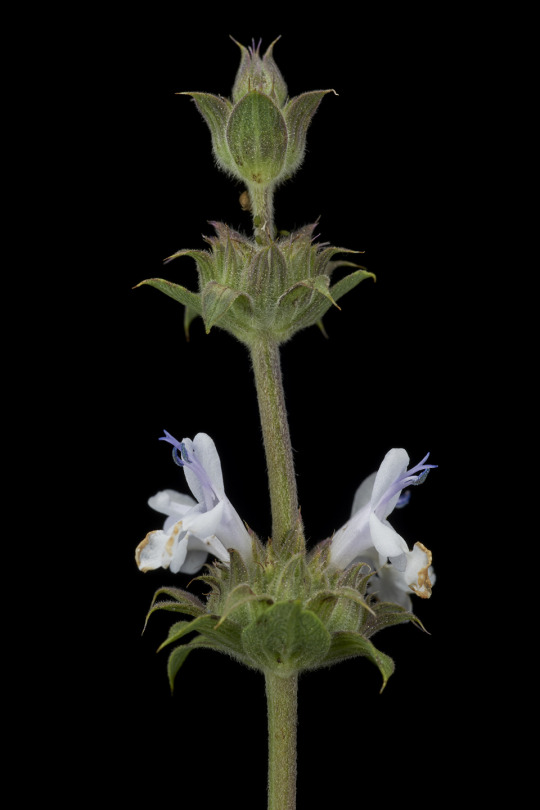

Salvia mellifera, black sage, is a perennial shrub in the mint/sage family native from central California down through the top of Baja California. It is part of the cast of plants present in coastal sage and chaparral habitat, thriving only in a specific range of rainfall in a mediterranean climate. The flowers host a variety of pollinators including butterflies, hummingbirds, and native bees and its seeds, like other Salvia species, are abundant and provide food for animals and birds. The fragrant leaves contain chemicals used by the Chumash to treat pain and a unique spicy honey is derived from the plant in the modern day.
115 notes
·
View notes
Text
There is a lovely patch of milkweed at work that just bloomed

In the western US sagebrush steppe ecosystem milkweed are one of the top plants associated with insect diversity (sagebrush comes in first, which is unsurprising as the entire ecosystem is named after it)

There has been a huge push in recent years to plant milkweed, as it helps the Monarch Butterfly, but just like other pushes to restore habitat for a specific species, this also helps so many other species.

Three species of bee in one frame! The abundance of species was glorious.

A red-femored milkweed borer beetle

Nevada Bumblebee

A striped sweat bee

A hairy footed scolid wasp

Cobalt milkweed beetle

Unknown bee species

American sand wasp
....and more
Small changes to human spaces can bring about such big results and it gives me such hope.
#milkweed#habitat restoration#botany#flowers#bees#beetles#wasps#insects#biodiversity#butterfly#monarch butterfly#bumblebees
20 notes
·
View notes
Note
Hey man, if you're alright with it, do you mind if I ask a question?
When I was a kid, I really had a love and passion for zoology and conservation. For various reasons, I couldn't really attend university right out of high school and just had to focus on living day to day. I'm in a better place now, I think, and I would like to dip my toes in conservation to see if it's something I could do for life. The problem is that the only way I really know how to do that is by throwing myself in school. I was wondering if you knew of anyways of how to participate at a local level? Like if there's resources to volunteer or to connect with other people in the field? Even if it's not something I'll do for a career with how the world is, it kind of hurts just to do nothing
I appreciate ya man and I hope you're doing well. Stay safe out there.
I love this ask, and I'm sorry about the delay in answering! I'm out in the field right now, and my access to the internet is pretty limited.
My first answer is that while school is definitely a pathway into biology or conservation, it's absolutely not the be-all end-all. There are tons of programs open to laypersons and beginners of all kinds. At the local level, I would start looking to see if there's any interesting conservation corps programs being run in your state! Corps work is a great resume builder & trainer on anything from habitat restoration to trail work to wildfire prevention. Another possibility is to identify the public lands in your locality, whether it's national forest, wildlife refuge, state parks, DNR or BLM land, etc., and reach out to ask about volunteer opportunities or citizen science programs. Many of these districts are starved for help, and will be incredibly enthusiastic about getting you involved.
As for getting involved with wildlife specifically, there are plenty of opportunities to follow in schoolwork, but a lot of my best experience builders have been outside of school! Look into wildlife rehabilitation programs or natural science centers where you live, and how you can get involved -- a lot of the time, just asking the right person will get you somewhere. Look into bird banding courses, too! Look into butterfly rearing! There is such a rich diversity of ways to participate in wildlife conservation, regardless of whether or not you have a degree.
57 notes
·
View notes
Text
Lunarpunk gardens
Okay, I'll admit I'm not on top of the whole aesthetics of the various -punk genres, but looks imo should be considered after function and ethics. SO...
I was inspired by this post and got to thinking about what a Lunarpunk garden would mean on my site.
I decided the most important part of the post was "Let me propose lunarpunk being more than just witchy aesthetics. It should be about reducing light pollution, protecting all endangered species including the ugly ones, and most of all seeing darkness as a coexisting counterpart and not something to conquer." So, that's three ideas that I can work with.
reducing light pollution: Working through this idea the same way I would evaluating an established garden in terms of layers and scale of objects in the space, at a site-level the only exterior lights are those at the front and back door. Various flying insects are very attracted to the back light, which is a normal incandescent bulb, and less are attracted to the front ones, which are green. In both cases, we never leave them on all night, but working off what several websites say about bulb color and warmth, I can swap all the bulbs for a warmer-tone LED bulbs and that would cause less issue when they are on at night. Scaling up, I'm not sure what I can do about the huge streetlight on our road, which has the most hideous white-light. Before I DO anything, I probably should dig into the city's files, since I know the bulbs were changed into those LEDs a few years ago, and maybe there was some thought put into that decision.
protecting all endangered species including the ugly ones: Given I'm looking at Lunarpunk, an obvious connection here was moths, the 'ugly' relatives of butterflies. Personally, I love moths and understand their greater ecological role compared to butterflies from a video presentation I watched a few months ago (I'll post that later). Focusing in on the "endangered" aspect, I used Xerces Society's 'Species Profile' tool to look at my state and see what moths are endangered in my area. (Side-note: I also looked at the other categories, like Bees, Beetles, etc. and nothing was specifically noted for my area, so I'm putting those categories on the backburner for ideas rn.) I identified three species of moth as endangered for my area: Diana Fritillary, Dukes' Skipper, and Early Hairstreak. The idea to then ID what plants the eggs and larvae need as host plants, what adults need for sustenance, and what mirco-climates I can make to support their life cycles.
Diana Fritillary (Speyeria diana) "As a forest-dependent species, threats to the Diana fritillary come mainly from forest management: logging operations and pest control... There is one flight from June to September. Males emerge before females and patrol within the forest. Females lay eggs later in the flight period, mainly August, walking along the ground and attaching eggs singly to twigs and dead leaves. As with other Speyeria species, the caterpillars hatch and hibernate without feeding. They emerge in spring to feed on the leaves and flowers of various species of violets. Adults feed on nectar from a variety of plants, including milkweeds (Asclepias sp.), ironweed (Vernonia sp.), and red clover (Trifolium pratense). Males will also drink fluids from dung...Habitats for the Diana fritillary are the edges and openings in moist, rich mountain forests. They will also use pastures, shrublands, and fields for nectaring but will only breed if there is a suitable forest margin. Larval hostplants are various species of violets (Viola sp.)" (quotes from Xerces Society).
So, this species wants a forest edge, which my neighborhood is certainly not; however, I have a decent handful of trees which I mulch using unprocessed leaf litter and stems over the winter, and this provides a decent base for supporting any number of species in my site. I also have lots of self-sown viola in the lawn and beds, which I greatly enjoy not only for their tiny and delicate looking flowers, but also the fulsome heart-shaped leaves the rest of the summer and autumn. I have two Swamp Milkweeds planted, and I'll consider more species as space and needs arise. So far, off to a good start.
Dukes' Skipper (Euphyes dukesi) "It can be found in a variety of moist habitats with long grass, such as marshes or ditches, but the primary habitat is patches of sedge—its main larval host plant—in forested swamps. Dukes’ skipper deserves conservation efforts wherever it is found. Its forested wetland habitat should be protected from drainage, logging, and spraying...In the mid-south, there are two between June and September... Adults visit open wetlands to drink nectar from flowers such as pickerelweed (Pontederia sp.), sneezeweed (Helenium sp.), hibiscus (Hibiscus sp.), and blue mistflower (Conoclinium sp.)...Dukes’ skipper can be found in a variety of moist habitats with long grass, such as marshes or ditches, but the primary habitat is sedge patches in forested swamps. Larval hostplants are sedges, including hairy sedge (Carex lacustris) and shoreline sedge (Carex hyalinolepis)" (Xerces Society).
Again, not a habitat that is immediate to my site. The good news is that I'm already starting several Swamp Hibiscus from seed this year for various spots, and I've been looking more into sedges for a couple wet spots. In particular, I want to run an open pipe from the AC drip into a spot where I removed a non-native 'hibiscus' this winter after some damage. I could feasibly do a few sedges around the Swamp Hibiscus. I doubt I would get a breeding population on my own, but if it becomes an effective use of the water, this might be a technique that I can demonstrate to others in the neighborhood - and again, it's a good habit for several species besides the Skipper.
Early Hairstreak (Erora laeta) "The habitat is mature deciduous and mixed woods containing its host plants, American beech and beaked hazelnut. As a forest-dependent species, both logging activities and pest control spraying are possible threats...There are usually one flight (May – mid-June) in the north and two flights (mid-April – mid-May and late- June – July) in the east. Rarely, a partial third flight (late-August – early-September) in the southern Appalachians. Males perch in treetops on ridges and hilltops to watch for females. Adults nectar on fleabane (Erigeron sp.), oxeye daisy (Leucanthemum vulgare), and steeplebush (Spiraea tomentosa) Early Hairstreaks spend a considerable part of their life in the canopy. Some observers note that adults visit moist ground in the morning (for example, along dirt roads) before returning to the canopy in the afternoon. Eggs are laid singly on the hostplant fruit. Caterpillars feed on nuts, initially the husk in early instars and later boring inside. Most of the year is spent as pupae, probably in the leaf litter" (Xerces Society).
I'm realizing now that the reason these three species are threatened so much is that their habitat is decidedly not urban or adaptable to the swathes of monocultures that have swallowed my area. I don't have any Beech or Hazel nut yet, but I do have some beechnuts sown in a pot, that I picked off the path in a local park. If those germinate, I can probably keep some in pots and maybe get one in the ground depending on the circumstances this summer. I don't have any of the nectar plants, except the fleabane which randomly pops as a volunteer ( a "weed" to those more judgmental about pioneer-recovery species), and I can look into Steeplebush seeds, since they do look gorgeous and I can probably sell the more reluctant in my household on that factor.
seeing darkness as a coexisting counterpart and not something to conquer
This one is a bit tougher to work with outside of my own praxis, specifically in convincing others visually through my site. Honestly, I think the best way to suggest this visually is in using plants that are either dark foliaged (I have a ninebark and planning on some corn that fit this bill) or silver foliaged/white flowering ( a garden sage I have in a pot and the sown buttonbush, maybe). In daytime, I'm hoping to focus a lot on bright masses of color paired with bright hardscape, like the existing white accents and planned turquoise painted pots. The dark foliage are native plants; the ninebark is a replacement for the awful barberries I spent hours hacking out, and the corn is "Flor de Rio" a burgundy-colored popcorn variety. Those alone I hope are visually different enough to catch people's interest, but I know a lot of people take walks in my neighborhood in the evening, at dusk or after dark. The white flowers and silver foliage might actually benefit from the harsh streetlight, here, shining out from the muted greens and darker foliage.
The easiest way to try and further this point is naturally to talk to people about the idea, but I think this visual communication/demonstration could serve as the backbone of those potential conversations.
further thoughts
Lunarpunk isn't a genre I've really worked with before, but I hope this interpretation of the idea (a dark/hidden counterpart to the more well known Solarpunk ethos) can meaningfully help people reconsider their biases about visibility and usefulness, and of course provide support to various critters in the area.
30 notes
·
View notes
Note
This is probably completely insane, but what if the Space Hares are actually Orb polyps?
I LOVE THIS INSANITY. This is not my personal theory but i am obsessed with your vision. maybe orbulon dad reveal was real all along.
Here is my personal thoughts on those crazy hares. While orbulon to me is like a jellyfish/hydrozoan/cuttlefish/beluga whale freak, when i see space hares i think of one thing. Sea angels!
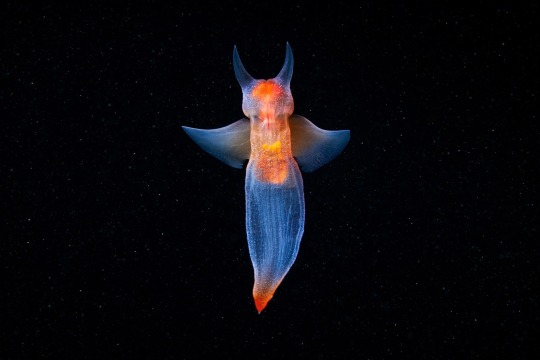
They are a cute little sea slug with what looks like cute little bunny ears. However they are not ears
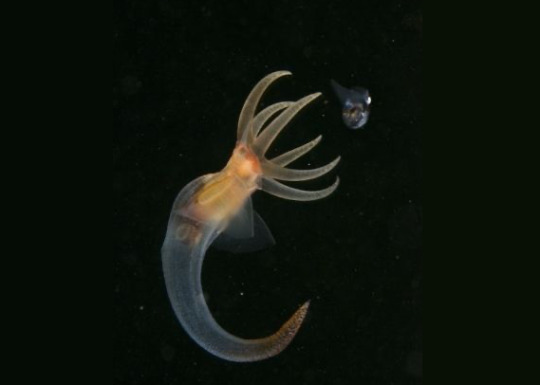
Also they are carnivorous. Sea angels specifically eat...other sea slugs. Not their own species, but those that are really closely related to them (sea butterflies). Still, it is very darkly funny to imagine alien bunnies eating each other cinnamon toast crunch style, so I do. This is my evil secret. They DO also eat carotene logs though, but I'd like to think that is simply a little treat that is actually not all that good for them (but they taste so good).
One last thing about these guys that completely diverges from the slug thing is that I think they reproduce via binary fission for the sole reason of I think that's funny. They are all clones of each other
Now for ORBULON, his life is way more complicated. When he is "born" he is just a tiny spore thing (a planula, but cartoony). As soon as he hits a surface he immediately anchors into it and becomes an orbupolyp. (This is the stage he reverts back to in order to renew his life cycle.) Unlike the orbularva and orbu-adult forms, the polyp is sessile and will be stuck to whatever spot he is anchored to. He is also not really fully conscious in this state so he will not be able to talk to you. In his natural habitat he would simply catch whatever food is floating by with tentacles at the end of his stalk (which will become his limbs later), but on earth there is no food floating by so they just kind of have to shovel food in there. It's really weird but this is the price we must pay. For the purposes of this assignment, I am decreeing that orbulon can politely tuck his feeding tentacles into each other when he isn't actively eating. This doesn't make sense if you know jellyfish but there is a reason i'm doing this.
Now without further ado: the orbupolyp

40 notes
·
View notes
Text
Moth of the Week
Red-Belted Clearwing
Synanthedon myopaeformis
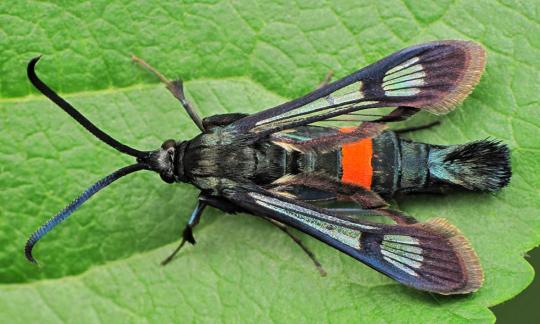
Image Source
The red-belted clearwing is a part of the family Sesiidae. It was first described in 1789 by Moritz Balthasar Borkhausen as Sphinx myopaeformis. This was later changed to Synanthedon myopaeformis. This moth is called the red-belted clearwing in Europe, the apple clearwing moth in North America, and the apple borer. This is due to their tendency to damage their host apple trees. It is considered a pest in Europe.
They may be confused with the large red-belted clearwing and the red-tipped clearwing.
Description This moth has a thin, dark blue, segmented body. The body is hairless aside from a bushy tail at the end of the abdomen. They are noticeable due to a bright red-orange band on one of the segments of the abdomen. The wings are clear with a dark outline and veins and a fringe on the outer margin (outer edge). The wings help distinguish the red-belted clearwing from the large red-belted and red-tipped clearwings as the wings have no red-orange markings.
Wingspan Range: 1.8 - 2.8 cm (≈0.71 - 1.1 in)
Diet and Habitat This species eats mainly apple, specifically Crab Apple (Malus sylvestris), as well as Pear (Pryus communis), Hawthorn (Crateagus monogyna), Almond (Prunus dulcis), Rowan (Sorbus aucuparia), apricots, cherries, mountain ash, peaches, plums, and quince. In Canada, adult moths have been attracted to the flowers of the snowy milkweed.
They can be found natively in Europe, North Africa, and Asia Minor. This species was noticed to North America and first detected in Canada in 2005. They inhabit well established orchards and gardens, hedgerows, open woodland, and mature scrub.
Mating Adults emerge from their cocoons in early summer and on flight from May to August, this is presumably their mating season. Females can lay up to 250 eggs, usually singly in the cracks or damaged areas of the trunk and branches they are hosting in. Females attract males with pheromones released from glands. A 2010 study found that 3,13-octadecadienyl acetate is the primary sex hormone.
Predators The larvae of this moth are preyed on by parasites, fungi, and bacteria. The main parasite of red-belted clearwing larvae is Liotryphan crassiseta. Other parasites are Nematodes, Steinernema sp. The fungi Beauveria bassiana and Metarhizium brunneum are common causes of death in larvae as well as the bacteria Bacillus thuringiensis.
Fun Fact
The adult red-belted clearwings are significantly less active on cold days compared to warm days.
In 2014, Judd and Eby found that S. myopaeformis does not discriminate between yellow, green and white or between purple, blue, red, and black. This suggests that they are dichromatic, meaning they can perceive mainly two colors. This affected traps set to catch this species as they acted differently depending on the light reflected.
As this species is considered a pest to apple trees, people have attempted to control the population. This has been tried with pheromone/mating disruption, pheromone laced traps, other chemical traps, the use of predators/enemies, and the covering of apple tree trunks in oil.
(Source: Wikipedia [1][2][3], Butterfly Conservation, Michigan State University)
#libraryofmoths#animals#bugs#facts#insects#moth#lepidoptera#mothoftheweek#sesiidae#red-belted clearwing#Synanthedon myopaeformis#apple clearwing#apple borer#very late post#sorry for the absence
54 notes
·
View notes
Text
One big thing that gets missed in the conversation about native plants is that when considering a plant, you really should ask two questions:
1. Where, specifically, is it native to?
2. Within that region, what ecosystem conditions does it live in? Will it thrive where you intend to plant it?
I cannot tell you how many times I've come across a plant labeled as native that doesn't even grow in my state. Sure, it's native to the continent, but not this side of the rocky mountains! That's not nearly specific enough if your goal is to support endemic animal species and the overall ecosystem.
You also need to consider what conditions that plant needs to thrive. One example I see a lot of here is planting understory plants in full sun. They're stressed out, they're getting sunburnt, and they're slowly dying. People will also try the reverse, planting praire plants in deep shade, and wonder why they're all floppy and anemic looking. Plants may be native to your area, but they still have specific needs and you will have much greater success if you match the conditions you have to a plant that will thrive there.
A third, extra credit question is a two parter: is it endemic (aka, unique to your region) or does it have a a broader, or even circumpolar distribution? I mean, check out the range maps for Henderson's shooting star & twinflower:

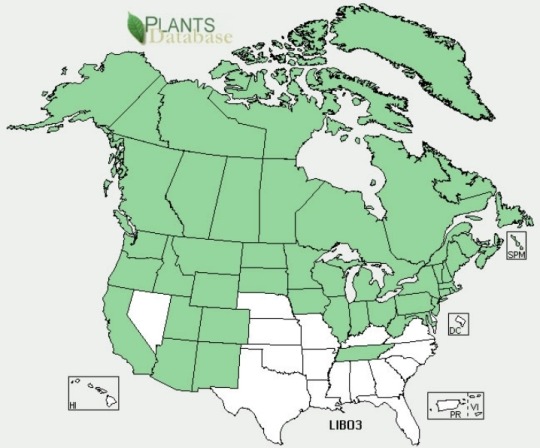
Twinflower is found across the northern portions of Eurasia as well.
The second part is, are any of the vulnerable species in your area depending on it? An example from my area is Viola Adunca, which has a pretty broad range,
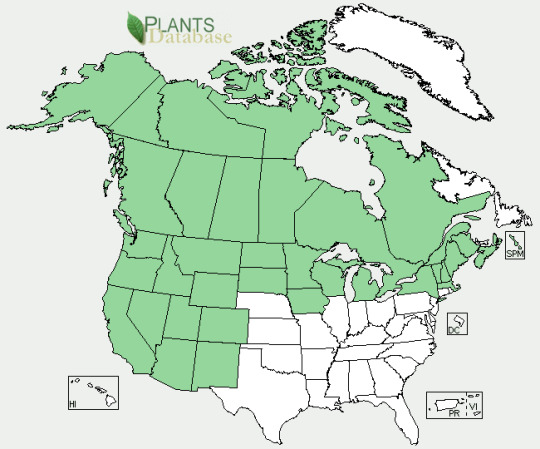
But is also host to multiple fritilary butterfly species in my area, some of which are on the decline and some of which are no longer found in my state. Due to habitat loss. Both due to human activity (agriculture, subdivisions, etc) and human inactivity (banning the intentional burns the Native peoples did, that maintained the Oak savanna ecosystem, leading them to be "invaded" by non-fire adapted Douglas firs, another native species. Also at the same time making the region more vulnerable to bigger and more devastating wild fires).
#gardening#native plants#native species#intentional fires were key to managing ecosystems throughout the west#and when our government killed#removed from the land#and then banned the remaining people from setting fires#we did so much harm to not only the ecosystems but also endangered ourselves#on top of the truly reprehensible behavior we showed to native peoples#I don't think people realize how much we changed the ecosystems here by banning fires#hunting beavers to near extinction#and killing off the bision and turning the land into range land for cattle & sheep
160 notes
·
View notes